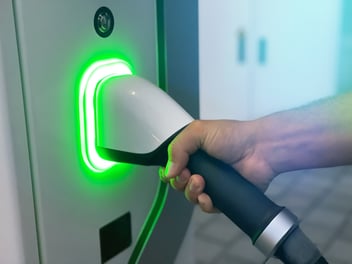Coolant For Electric Vehicle Fleets: What to Look For
If you manage an electric vehicle fleet, at some point you might've asked yourself: "What kind of coolant do I need for these new electric vehicles? Is it different than what I had in my old ICE vehicles?"
The simple answer to that second question is "yes."
Next-generation EV fleets require next-generation EV coolants, for a variety of reasons that we'll outline below. 
Electric Vehicle Fleets on the Rise
First, let's talk about the state of electrification in fleets.
When many people hear the phrase "electric vehicle," the image of an EV parked in a grocery store charging spot might immediately come to mind. But the reality is, as other commentators note, the electric vehicle story is much bigger than that.
“The electric-vehicle story is much larger than just the retail story,” said Zo Rahim, senior manager of Research and Market Intelligence at Cox Automotive. “In many ways, electric vehicles can be an ideal solution for many fleet operations, which often have set routes of known distances, vehicles that routinely overnight in the same location, and operations that prioritize the cost of ownership. The fleet business is significant in the U.S. market, and we expect the EV share of the fleet market to expand in the coming years.”
According to a Cox Automotive report last year, 14 percent of fleets operated EVs, "with a significant trend toward EV adoption expected in the next five years."
Another striking takeaway from the Cox report, titled "Future of Fleets: Path to EV Adoption," is that among fleet owners who currently operate EVs, 90 percent indicated they would be getting additional EVs during the next acquisition cycle.
In a nutshell, electrification is happening in the fleet industry, and some fleet decision-makers are feeling more prepared than others.
One last note from the study: less than 40 percent of fleet decision-makers indicated they were highly prepared for EVs. Some of that feeling of less preparedness is due to lack of local infrastructure, it is important to mention that fleet managers should try to keep up to date on electrification trends so they can be ready to act when the time comes (e.g., when infrastructure improves on their local routes).
What Procurement Leaders Need to Know About Coolants for Commercial EV Fleets
As battery electric vehicles (BEVs) gain traction in the commercial and vocational space, procurement teams are facing new challenges — especially when sourcing critical components like coolants.
If you're managing parts, fluids, or consumables for Class 5-8 vehicles (e.g., trucks, buses, vocational fleets), your traditional coolant suppliers may no longer meet your specs (or your risk tolerance).
Here’s why EV-specific coolant procurement is essential and what you need to look for in a supplier.
Why EV Coolants Are Not One-Size-Fits-All
Battery electric vehicles differ fundamentally from internal combustion engines (ICEs), especially in thermal management.
A standard coolant won’t cut it, as they can actually introduce safety risks.
Key Differences That Matter to Procurement
-
Electrical Conductivity: High conductivity fluids can cause battery short circuits or fires
-
Material Compatibility: BEVs use different metals (like aluminum and copper), requiring new corrosion inhibitors
-
Thermal Demands: BEVs produce heat differently and need quicker, more efficient cooling
Sourcing an EV-optimized coolant isn't just about spec compliance: it's a risk mitigation and performance assurance strategy. Just like any other product, you want to make sure you use the right products to keep your system going for as long as possible.
What to Look for in a Coolant for EV Fleet Applications
As a procurement decision-maker, you're not just buying fluid: you’re investing in fleet uptime, component longevity, and warranty compliance.
Here are the must-have properties in a coolant designed for battery electric commercial vehicles:
Ultra-Low Electrical Conductivity (<100 μS/cm)
- Prevents system shorts
- Reduces fire risk
- Avoids need for expensive filtration add-ons
Corrosion Inhibition for BEV-Specific Metals
- Protects key components made of aluminum and copper
- Ensures compatibility with modern BEV materials
Formulation Stability
-
Maintains pH and conductivity across long duty cycles and temperature changes
-
Lowers risk of system degradation and unplanned maintenance
Thermal Conductivity
-
Supports fast, efficient heat dissipation
-
Protects battery, motor, and electronics from overheating
Test-Backed Performance
-
Look for ASTM D8485 and modified D1384 testing specific to BEVs
-
Request visual test data for real-world component performance
The Right Coolant Can Lower Your Fleet's Total Cost of Ownership (TCO)
From a procurement standpoint, TCO is a critical piece of the profitability puzzle for you. If you're having to spend more on maintenance due to the use of a faulty or mismatched coolant and your TCO will skyrocket.
EV coolant plays a major role in long-term value. With the right coolant, you can claw back some of those lost dollars and keep your costs down.
Here’s how a high-quality coolant impacts your bottom line:
-
Reduces unplanned downtime due to overheating or corrosion
-
Extends lifespan of high-value components like batteries and motors
-
Supports OEM warranty compliance (using the wrong coolant can void coverage)
-
Minimizes maintenance costs with stable, low-degradation performance
EV Fleet coolant Sourcing Strategy Tip: Don’t Wait Until Failure
BEVs may be relatively new, but sourcing delays, spec mismatches, and warranty issues are not.
A proactive coolant procurement strategy ensures:
-
Fewer supply chain disruptions
-
Faster fleet deployment readiness
-
Lower long-term operating cost
Again, you don't want to wait until something becomes a problem. Fleet managers have to stay up to date on develops in the performance fluids sector, particularly coolants, if they hope to have a successful expansion of their EV fleet (or begin the electrification process).
SUMMARY: IF YOU'RE A FLEET MANAGER, READ UP BEFORE IT'S TOO LATE
Let's circle back to one of the figures from the Cox Automotive study cited earlier about preparedness for EVs. In that study, 39 percent of respondents indicated they were highly prepared for EVs because they and their company had done extensive research.
Now, the reality is there might be some limiting factors for your fleet, like local infrastructure (i.e., lack of charging stations).
However, it's important to think ahead and arm yourself with information so you can act when facts on the ground change. While a given fleet's coverage area might not be EV-friendly now, that could change in the next five years.
In any case, more knowledge never hurts, so we hope this brief guide offers a starting point for fleet managers and procurement professionals to know what they should be looking for in an EV coolant.
As a manufacturer of EV coolants — in addition to coolants for fuel cell applications — Dober is always happy to chat about the ins and outs of next-generation coolants (if you haven't already, you can check out a brief video summary of our coolant R&D journey).
If you're a fleet manager looking into electrification and want to learn a little more about what's on the market, download the Dober product catalog to take a look at our offerings.




-1.png?width=352&name=PFD%20-%20Product%20Page%20-EV%20SLC%20(2)-1.png)